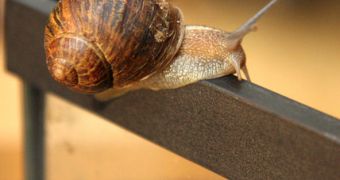For decades, biologists have believed that snails and slugs are heavily reliant on the slimy mucus their one foot secretes. Experts thought that this was what facilitated the creatures' movements, but a new study contradicts that belief, showing that the slime is not an essential part of locomotion.
Snails and slugs have a single foot, which is highly muscular, and which secretes a form of mucus. This is visible in the slime trail the creatures leave behind as they move forth. Studies of this substance revealed it has interesting physical properties.
Therefore, it was widely believed that these properties were essential for locomotion in these two types of animals. In the new research, experts at the Stanford University demonstrated this is not the case.
Stanford graduate student Janice Lai and her team found that the slime is not necessary for motion, and that the animals can easily move without its presence. The group used high-resolution videos and a laser-based study setup to conduct this investigation.
“We were surprised to find that the special mucus properties weren't essential. Mucus is still very important, but we found that there are other mechanisms that the snail uses to generate the traction to move forward,” Lai explains.
The expert has been investigating snail locomotion since 2007. As a mechanical engineer at the university, she was the first author of a study detailing this form of movement. The work appeared in the October 2010 issue of the esteemed Journal of Experimental Biology.
She also presented a mathematical model of snail locomotion in November 2010, at the annual meeting of the American Physical Society (APS 2010). Her data are now being used by other research groups studying how snails and slugs get around.
On a flat surface, all that the creatures need to move forward are muscular pulses. These travel in waves along the length of the foot, from head to tail. The pulses move faster than the animals do, and so the difference in speed provides traction.
Studies have however determined that the mucus is very important when the creatures want to travel on the ceiling or on vertical surfaces. In these cases, it provides additional traction, and also the ability for the snail or slugs to stick to these surfaces.
The goal of such studies is twofold – to understand snail motion, and also to gain the ability to replicate it in robots. Synthesizing the mucus in the lab could enable the creation of advanced mechanical systems that could use all types of surfaces as a base of operations.

 14 DAY TRIAL //
14 DAY TRIAL //